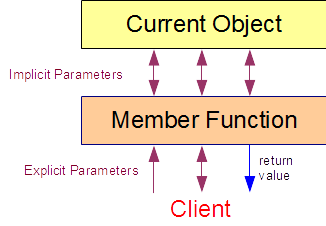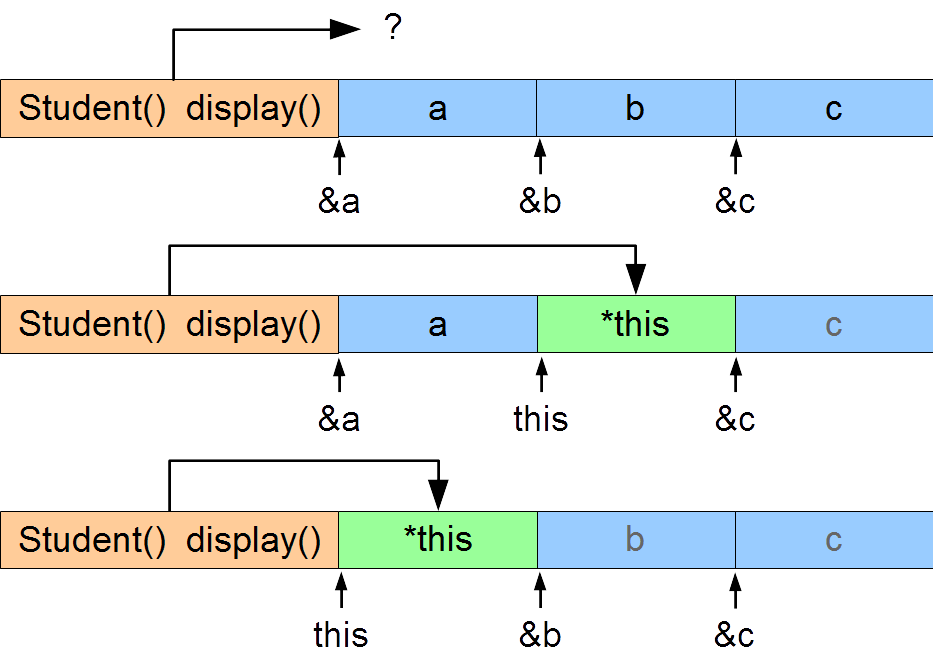The Current Object
- Distinguish a member function's access to instance variables and client variables
- Access the current object from within a member function
"Each member function knows what object it was invoked for and can explicitly refer to it" Stroustrup, 1997.
Once client code calls a member function on an object of its class and before that function returns control to the client code, that member function may need to refer to its host object. We refer to the host object from within a member function as the current object for that function. In other words, the current object is the region of memory that contains the data on which a member function currently operates.
This chapter describes the mechanism by which a member function accesses its current object and shows how to refer to that current object from within the function.
Member Function Parameters
Member functions receive information through parameters and return information through a return value and possibly some of their parameters. The parameters of any member function are of two distinct kinds:
- Explicit: Access the client code
- Implicit: Access the instance variables

Explicit parameters receive information from the client code and return information to the client code. We define them explicitly in the header of a member function. Their lifetime extends from entry to the function to exit from the function. They have function scope.
Implicit parameters tie the member function to the current object.

The syntax of a normal member function call reflects this two-part mechanism. The name of the object on which the client code invokes the function identifies the implicit parameters, while the arguments that the client code passes to the function initialize the explicit parameters.
Consider the constructors and calls to the display() member function in the following code snippet:
// ...
Student::Student(int s, const float* g, int n)
{
cout << "Entering 3-arg constructor\n";
set(s, g, n);
}
void Student::display() const {
if (no > 0) {
cout << no << ":\n";
cout.setf(ios::fixed);
cout.precision(2);
for (int i = 0; i < ng; i++) {
cout.width(6);
cout << grade[i] << endl;
}
cout.unsetf(ios::fixed);
cout.precision(6);
} else {
cout << "no data available" << endl;
}
}
int main () {
float gh[] = {89.4f, 67.8f, 45.5f};
float gj[] = {83.4f, 77.8f, 55.5f};
Student harry(1234, gh, 3),
josee(1235, gj, 3);
harry.display();
josee.display();
}
Entering 3-arg constructor
Entering 3-arg constructor
1234:
89.40
67.80
45.50
1235:
83.40
77.80
55.50
Entering destructor for 1235
Entering destructor for 1234
The constructor for harry receives data in its explicit parameters and copies that data to the arguments in the call to the set() member function on the current object, which consists of the instance variables for harry. The constructor for josee receives data in its explicit parameters and copies that data to the arguments in the call to the set() member function on the current object, which consists of the instance variables for josee.
The first client call to the display() member function accesses harry through its implicit parameters. The second client call accesses josee through its implicit parameters.
this Keyword
The keyword this returns the address of the current object. That is, this holds the address of the region of memory that contains all of the data stored in the instance variables of current object. *this refers to the current object itself; that is, to the complete set of its instance variables.
We use the thi`s keyword within a member function to refer to the complete set of instance variables that that member function is currently accessing through its implicit parameters.
The figure below illustrates usage of the keyword. The top memory map shows two member function and three Student objects. The question mark indicates that the data on which the member function logic operates is unknown. The middle memory map identifies the data when the member functions are called on object b. The bottom memory map identifies the data when the member functions are called on object a.

For example, for the display() member function to return a copy of its host object, we write:
Student Student::display() const {
// ...
return *this;
}
int main() {
float gh[] = {89.4f, 67.8f, 45.5f};
Student harry(1234, gh, 3), backup;
backup = harry.display();
backup.display();
}
Entering 3-arg constructor
1234:
89.40
67.80
45.50
Entering destructor for 1234
Entering destructor for 1234
Entering destructor for 1234
Entering destructor for 1234
The keyword this has no meaning outside a member function.
Reference to the Current Object
We can improve this definition of display() by returning an unmodifiable reference to the current object rather than a copy of the object. This would improve performance if the object was large, since copying all of its instance variables would be compute intensive. Returning a reference only copies the object's address, which is typically a 4-byte operation:
const Student& Student::display() const {
// ...
return *this;
}
The const qualifier on the return type prevents client code from placing the call to the member function on the left side of an assignment operator and thereby enabling a change to the instance variables themselves.
Assigning to the Current Object
To copy the values of the instance variables of one object into those of the current object, we dereference the keyword and use *this as the left operand in an assignment expression:
*this = ...;
Example - Validated Input
Let us introduce a member function to our Student class called read() that:
- Extracts data from standard input
- Stores that data in a temporary
Studentobject - Copies the temporary object to the current object only if the temporary object is not empty
- Leaves the current object unchanged if the temporary object is empty
To avoid duplicating validation logic, we:
- Construct a local
Studentobject passing the input data to the three-argument constructor - Let the internal logic determine whether to accept the data or place the object in a safe empty state
- Assgin the local object to the current object if the temporary object accepted the data
void Student::read() {
int no; // will hold the student number
int ng; // will hold the number of grades
float grade[NG]; // will hold the grades
cout << "Enter student number : ";
cin >> no;
cout << "Enter number of grades : ";
cin >> ng;
if (ng > NG) ng = NG;
for (int i = 0; i < ng; i++) {
cout << "Enter student grade : ";
cin >> grade[i];
}
// construct the temporary object
Student temp(no, grade, ng);
// if data is valid, the student number is non-zero
if (temp.no != 0)
// copy the temporary object into the current object
*this = temp;
}
Since the temporary object (temp) and the current object are instances of the same class, this member function can access each object's instance variables directly.
Summary
- The current object is the current host object for the member function a member function's parameters consist of implicit and explicit parameters
- A member function's explicit parameters receive information from the client code
- A member function's implicit parameters bind the function to the instance variables of current object
- The keyword
thisholds the address of the current object *thisrefers to the current object itself- The keyword
thisis meaningless outside a member function